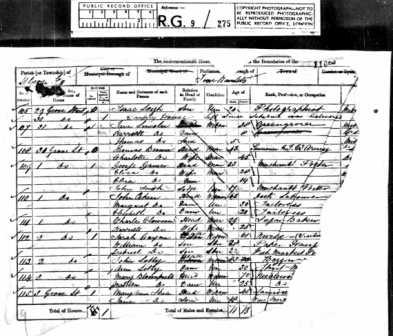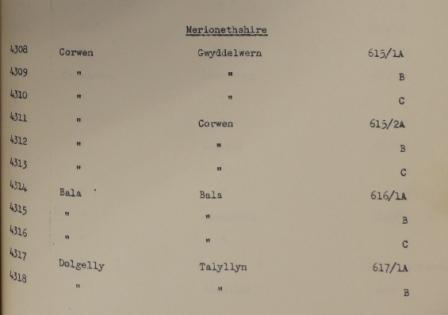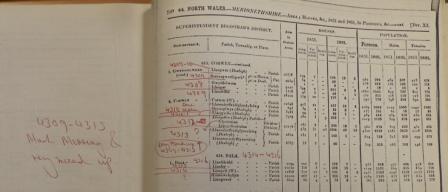
The 1861 census has suffered more damage than most (RG 9/275 f110)
You might think that because all the censuses for England and Wales (and the Channel Islands, the Isle of Man) have been digitised, indexed and put online, there is nothing more that needs to be done to catalogue them. Think again.
Once upon a time, you had to search the census by place, using the microfilm version. If your memory goes back far enough (mine doesn’t) you might even have looked at the paper originals. Either way, you would use the paper catalogue and finding aids to find the piece reference for your parish or place. If it was a large town, and you had a street address to search for, there might even be a street index. When the old Public Record Office catalogue was first put online as PROCAT in 2000, you could look up a place name and go straight to its piece reference(s), although you would still have some searching to do on the film. The real benefit of an online catalogue, though, is that you can do more than one kind of search. For example, there are some parts of every census that are known to be missing, so you could now search for the words ‘missing’ or ‘wanting’, restricting your search to the reference for a particular year, and get an instant list. PROCAT was re-named the Catalogue in 2004, and is now part of Discovery, but the underlying data is the same.
On websites such as Ancestry.co.uk and Findmypast.co.uk, you can now search by name, by place and sometimes by street too. This makes a lot of census searching much easier, but our catalogue descriptions in Discovery are still vitally important.

Detail from an old paper 'Class List' for the 1861 census (RG 9)
In the old ‘Class Lists’ (now called series lists) all the places in a census appeared in reference order, and you can still view them this way by browsing in Discovery. This is still useful because the 1841 to 1891 censuses are arranged differently on Ancestry.co.uk, our official partner for those census years; on their site you can browse by civil parishes within counties, but the census is based on registration districts, which do not fit neatly into this structure.
If you browse by place in some census years Canterbury, for example, appears to have only two or three enumeration districts, but the rest are not missing, they are listed under individual parish names such as Westgate Without, St Mary Moses and so on. This is fine if you are familiar with Canterbury and its parishes, but can be very confusing if you are not. On the other hand, if you search for Canterbury in Discovery, restricting your search to a census series, HO 107, RG 9 etc, you will find all of the Canterbury parishes together (useful Discovery tip: you can re-sort your results into reference order using the drop-down menu at the top of the results page). The same applies to many other towns. You will also find smaller places such as townships and hamlets listed in Discovery that are not always included in the lists of parishes, so all the old cataloguing information is still very useful.
The series lists, whether on paper or online, were not the only means of finding people and places in the census before it was placed online. There were various other supplementary finding aids, and the most heavily-used of these used to be the street indexes, which were compiled for towns with populations of 40,000 or more. Hard copies of these are still available in our reading rooms, and those for 1841, 1851, 1861, 1871 and 1891 were placed online as part of the Historical Streets Project, now part of the UK Government Web Archive.
Other finding aids included copies of the printed Population Tables from the census reports, containing hand annotations about missing parishes and districts, the availability of street or name indexes and other information. Although some of this information was added to the paper series lists, the staff reference copies always contained more detail, as in the example below, which covers roughly the same area as the public version above.
There have always been more problems with the 1861 census than any other year, because the original books were kept in unsuitable conditions for a time before they came into the custody of the old Public Record Office, and sustained some damage, especially to the covers and outer pages. Some people have suggested that as much as 15% of this census is missing, but there is no evidence to support this, the real figure is likely to be about 3-5%, which is quite bad enough.

'Much Missing and very mixed up': staff reference copy of the Population Tables for the 1861 census (RG 9)
When the old paper lists were first compiled, no-one could have foreseen the introduction of online catalogues. The way that information was presented made perfect sense in paper format, but was not always ideal for transferring directly to an online database. Our Cataloguing team has been working very hard behind the scenes to improve the information underlying first PROCAT, the Catalogue, and now Discovery. One of their recent projects has been to streamline and improve the various record series containing the census. One of the very welcome results of this is that piece level descriptions are no longer infested with the dreaded ‘Description available at other catalogue level’.
This is a very welcome improvement, but even better than that, some valuable new information has been added for the 1861 census. Although details of missing parishes and districts have been catalogued for a long time, details of odd missing pages have not. Over the years we have gathered information about them, and maintained an increasingly large database to which only staff had access. Now this has been uploaded to Discovery, so that you can check for yourself if pages are known to be missing from a part of the 1861 census you are interested in. This information is not comprehensive, but coverage is good for London and south east England, with partial information for several other counties. As information comes to light for other parts of the country, often as a result of reader enquiries, we shall add that too. We have details about missing pages in other census years too, which we hope to add to Discovery in due course.
Over the years some unidentified pages and fragments of the census have been restored to their rightful places, the result of clever detective work by staff or readers. Some poor pages are still ‘orphaned’ but I have worked out where some of them came from, so they can soon be restored too. But that’s another story.
Thank you, Audrey, a fascinating post; and thanks, too, to you and your TNA colleagues for these improvements.
I notice that the Historical Streets Project page says “in order to put in document references and folios on Ancestry you need to use the old search”. Since Old Search is about to disappear, will Ancestry address this requirement, do you know?
Very helpful information since I am living in the US and am not very familiar with county boundaries, etc.
Pleased to observe attempt to ” standardise” , the census returns. Personal knowledge of the various inhabited places was a boon, otherwise a feeling of being totally lost soon overtook good intentions. Noticed recently misinterpretation
of the H/O or R/G identification numbers. Other numbers have been seen which do not relate to any definite census year. Created thoughts of , “Who on earth has catalogued this “.
Another problem often occurs when using the internet when there is no film number, no folio number, no place name shown on the census page requested
all having been trimmed off for some unknown reason. Leaves one wondering which and what census or place you are looking at.
That upsets all the good work done with that marvellous bunch of volunteers who
transcribe all the relevant material.
Own method of using census returns is the H/O or R/G number, for the year,
followed by Folio Number, then Page No. and finally the schedule Number
which appears in the left hand column on the return. The address is next to that schedule number. Normally the “Head of the Household” appears next along the same line. Missing or out of place pages very often upset intentions.
I was fortunate with employment which involved travelling and was a great help geographically. Now retired and enjoy the hobby very much.
Cyril
I am glad that you are pleased with our improved cataloguing of the census, and that you are enjoying tracing your family history. However, I should point out there has been no change in the way that the census is catalogued, we have just tried to make it easier to use, and, in the case of 1861, to add more detail to the descriptions.
The National Archives (and before that the Public Record Office) has always held the census returns in series HO 107 for 1841 and 1851, and then RG 9 for 1861, RG 10 for 1871 and so on, up to RG 14 for 1911, the most recent census to be released. The correct way to cite the reference for a census page is similar to the method you describe; series, piece and folio for 1851 to 1901 eg HO 107/1501 f23 or RG 10/3004 f4 etc. For 1841 you also need a book number eg HO 107/104 Book 9 f5. A page number can also be useful, but is not essential since the folio covers only two pages, so any entry can easily be found from that. For the same reason schedule numbers can be helpful, but are not essential, and they are not used at all in the returns for vessels or institutions.
Over the years many family history societies and other organisations have created indexes to the census for their own areas. Most of them have used the correct form of reference as I described above, or a close variant of it, although some have used completely different methods of their own devising. The same goes for some individuals who have included references to census returns in their own family histories which they have posted on their own sites, or in family trees on sites like Ancestry and My Heritage. I agree with you that some of these can be very difficult to interpret.
I am not quite sure what you mean by ‘misinterpretation of the HO or RG numbers’, but if you have found any problems with them on our website, on in Discovery, our catalogue, please let us know and we can investigate. Many of the amendments that we make to our catalogue are the result of notifications from sharp-eyed researchers!
That’s a good point, Frances. Fortunately, the functionality of Ancestry’s New Search has improved since it was introduced, and it does now incorporate the full reference search facility with field for piece, folio and page (and also book number in 1841).
I get this when I look in DISCOVERY for the missing roads of Teddington in 1861 Census
Is that it? Is there anywhere else I might look for the missing pages? Keith Atkinson
Registration Sub-District 4 Hampton. Parish: Hampton (Middx); Hamlet: Hampton (1); Hamlet: Hampton Wick. Parish: Teddington …
…1861 Census Returns. SURREY. Registration District 47. KINGSTON. Registration Sub-District 4 Hampton. Parish: Hampton (Middx); Hamlet: Hampton (1); Hamlet: Hampton Wick. Parish: Teddington (Middx). Missing pages: Enumeration district 3: 3-4 (55 persons); Enumeration district 10: 13-23 (end) (244 persons). …
Collection: Records of the General Register Office, Government Social Survey Department, and Office of Population Censuses and Surveys
Date range: 1861
Reference:RG 9/458
Subjects:Census
I’m afraid that when the pages were lost, they were lost forever. However, if you are lucky, you can sometimes fill in some of the gaps from other sources. These could be parish registers, poor law records, rate books, wills and so on, mostly held in local record offices.
I am have details of a letter written in 1913 when it seems a family member paid to examine to 1841 census. In her letter she refers to the records as the licenses papers (sic) and she paid 5/- and spend about 10 hours looking through the papers. She writes from ?? Mining Exn, London. Is this where the 1841 census was kept in 1913 and would they be referred to as licenses papers? Intriquingly she seemed to be trying to trace the same family member that I am over 100 years later! Any ideas?